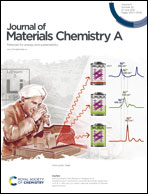Ternary copolymers containing 3,4-dicyanothiophene for efficient organic solar cells with reduced energy loss†
Abstract
The power conversion efficiencies (PCEs) of organic solar cells (OSCs) based on non-fullerene acceptors are still limited by large energy loss (ΔEloss). Herein, we report an easy and feasible way to reduce the ΔEloss, specifically the energy losses caused by non-radiative recombination of OSCs via introducing 3,4-dicyanothiophene (DCT), a structurally simple building block with strong electron-withdrawing ability, into a state-of-the-art donor polymer PBDB-TF to form ternary copolymers. The effects of DCT content in the ternary copolymers on the optical properties, energy levels, film morphology, charge transport, photovoltaic performance, and energy losses are studied comprehensively. Significant efficiency improvement in OSCs has been achieved by the DCT-based ternary copolymers as compared to the benchmark polymer PBDB-TF mainly because of a higher open-circuit voltage enabled by the reduced non-radiative recombination energy loss. A high PCE of 16.6% and a low non-radiative recombination energy loss (0.22 eV) were achieved in ternary OSCs with the DCT-based terpolymer as the electron donor and Y6-BO and PC71BM as the electron acceptors.



 Please wait while we load your content...
Please wait while we load your content...